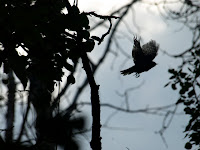Despite the fact that it is Halloween, the weather is unusually fine. It has been for the whole month of October. In fact, although it is cooler at night, the sun has been shining and warming things up very nicely during the day. The local birds, actively chirping their delight, is what drew me out and into the little forest just down the street. Nothing else seemed more important.
 |
| Pine Grosbeak |
I didn't expect to see anything other than the local species of birds. So when I heard the most intriguing birdsong, which was also unfamiliar, and totally out of season it seemed to me, I naturally had to find the source. That took me a while, as I had to go off trail to do so, but I am so glad that I did.
 |
| Looking around |
 |
| Pine Grosbeak and Junco |
Right in the heart of the little forest, the song was the loudest,
allowing me to pin point a direction and then to spot a flash of red,
where it had no business being. When the red bird landed on a naked branch, my first thought was - White-winged Crossbill! My second thought was, it certainly has a beautiful song. I managed to get a few photos, but before I knew it the bird was gone. Nothing unusual in that. Birds need to be actively feeding to stay alive at this time of year, so they are always in motion. However, something about the bird nagged at me, but although I tried to track it, I didn't see it again.
The thing is, the White-winged Crossbill can be easily confused with several
species of birds and vice versa. The trick is to get a really good
look, and I didn't. I only had a minute at best to take the photos.
When I finally had a look at my pictures, I found my first thought about the bird's identification had been wrong. Lucky for me, because I had definitely captured images of a Pine Grosbeak instead. A first sighting for me, as well as real treat. Is it strange to be happy to be wrong?
To learn how to tell the difference between the Pine Grosbeak and White-winged Crossbill just follow my link:
http://susansheadspace.blogspot.com/2010/03/red-bird-update.html
Enjoy,
Guni
 Subscribe in a reader
Subscribe in a reader























